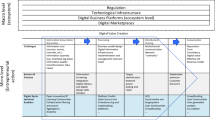Abstract
Creative behaviour has been claimed to be a vital ingredient for the inventions and innovations that are indispensable for the dawning knowledge society. The causality between creativity, knowledge development and innovation ascribes creative knowledge environments an important role as work settings in which people produce new knowledge. The Creative Knowledge Environment approach reaches beyond the Triple Helix model—promoted in innovation policy and research—in its potential to acknowledge creative environments outside academia, industry and government. This is a relevant contribution since the public funding of Triple Helix constellations has been criticised for paradoxically consolidating old structures rather than opening up for creative change. In this article, the model of Women Resource Centres (WRCs)—developed in Sweden and internationalized throughout Europe—serves as an example of how creativity in the organization of joint action networks can make new knowledge and innovation prosper. These centres were initiated in order to promote gender equality in regional development policy, enhancing women’s realization of business ideas and innovations. The model of Women Resource Centres illustrates the need for further development of predominant models for promoting innovation. Suggested concepts such as Creative Knowledge Environments and Quadruple Helix have the potential to increase the diversity of actors and areas being acknowledged as important in the expanding knowledge economy, by including the civil society and creative industries. However, the example of WRCs exposes an aspect of creativity and innovation that is not properly addressed in the suggested models, namely the aspect of gender.

Similar content being viewed by others
Notes
‘Innovation systems’ are a type of joint action networks where actors from the public, private and academic sectors cooperate. The main purpose with this cooperation is to enhance the development of new knowledge that is relevant to all three sectors, and to transform this knowledge into innovations.
References
Aagaard Nielsen K, Svensson L (eds) (2006) Action research and interactive research—beyond practice and theory. Shaker, Maastricht
Acker J (1999) Gender and organisation. In: Saltzman CJ (ed) Handbook of the sociology of gender. Plenum, New York
Butler J (1990) Gender trouble—feminism and the subversion of identity. Routledge, London
Campbell DFJ (2006) The university/business research networks in science and technology: knowledge production trends in the United States, European Union, and Japan. In: Carayannis EG, Campbell DFJ (eds) Knowledge creation, diffusion, and use in innovation networks and knowledge clusters. Praeger, Westport
Carayannis EG, Campbell DFJ (2006) “Mode 3”: meaning and implications from a knowledge systems perspective. In: Carayannis EG, Campbell DFJ (eds) Knowledge creation, diffusion, and use in innovation networks and knowledge clusters. Praeger, Westport
Carayannis EG, Campbell DFJ (2009) ‘Mode 3’ and ‘quadruple helix’: toward a 21st century fractal innovation ecosystem. Int J Technol Manag 46(3–4):201–234
Carayannis EG, Campbell DFJ (2010) Triple Helix, Quadruple Helix and Quintuple Helix and how do knowledge, innovation and the environment relate to each other? A proposed framework for a trans-disciplinary analysis of sustainable development and social ecology. International Journal of Social Ecology and Sustainable Development 1(1):41–69
Danilda I, Lindberg M, Torstensson B-M (2009) Women resource centres—a Quattro Helix innovation system on the European agenda. Paper presented at Triple Helix VII, 17–19 June 2009, Glasgow, UK
European Union (2010) Europe 2020—a strategy for smart, sustainable and inclusive growth. Communication from the commission
Fagerberg J, Mowery DC, Nelson RR (eds) (2005) The Oxford handbook of innovation. Oxford University Press, Oxford
Fenstermaker S, West C (eds) (2002) Doing gender, doing difference—inequality, power and institutional change. Routledge, London
Ghaye T, Gunnarsson E (2009) Creating cultures of appreciation: organisational innovation through employee well-being. In: Döös M, Wilhelmson L (eds) Organising work for innovation and growth experiences and efforts in ten companies. VINNOVA Report 2009: 22. VINNOVA, Stockholm
Gibbons M, Limoges C, Nowotny H, Schwartzman S, Scott P, Trow M (1994) The new production of knowledge—the dynamics of science and research in contemporary societies. Sage, London
Hemlin S, Allwood CM, Martin BR (eds) (2004) Creative knowledge environments—the influences on creativity in research and innovation. Edward Elgar, Cheltenham
Johansson AW (1997) Att förstå rådgivning till småföretagare (To understand business counselling to SMEs). Dissertation. Bjärred: Academia adacta
Johansson AW (2008) Förändrad rådgivning - ett sätt att frigöra kvinnors företagsamhet (Changed business councelling—a way to liberate women’s entrepreneurship). In: Larsson P, Göranson U, Lagerholm M (eds) Sesam öppna dig! Forskarperspektiv på kvinnors företagande (Sesam, open up! Research perspectives on women’s entrepreneurship). VR 2008:20. Vinnova, Stockholm
Leydesdorff L, Etzkowitz H (1996) Emergence of a triple helix of University–Industry–Government Relations. Science and Public Policy 23(5):279–286
Lindberg M (2007) Deconstructing gender and innovation—four regional networks challenging Sweden's innovation policy. Paper presented at past, present and future, 14–17 June 2007, Umeå, Sweden
Lindberg M (2010) Samverkansnätverk för innovation - en interaktiv & genusvetenskaplig utmaning av innovationspolitik och innovationsforskning (Joint action for innovation—a participative and gender scientific challenge of innovation policy and innovation research). Dissertation, Luleå University of Technology, Luleå
Mac Gregor SP, Marques-Gou P, Simon-Villar A (2010) Gauging readiness for the quadruple helix: a study of 16 European organizations. J Knowl Econ 1(3):173–190
Maldonado V, Lobera J, Escrigas C (2009) The role of higher education in a new quadruple helix context. Paper presented at Triple Helix VII, 17–19 June 2009, Glasgow, UK
Nowotny H, Scott P, Gibbons M (2001) Re-thinking science—knowledge and the public in an age of uncertainty. Polity, Cambridge
Parken A, Rees T (2010) Total control? The gendering of ‘triple helix’. Paper presented at Triple Helix VIII, 20–22 October 2010, Madrid, Spain
West C, Zimmermann DH (1987) Doing gender. Gend Soc 1(2):125–151
Author information
Authors and Affiliations
Corresponding author
Rights and permissions
About this article
Cite this article
Lindberg, M., Danilda, I. & Torstensson, BM. Women Resource Centres—A Creative Knowledge Environment of Quadruple Helix. J Knowl Econ 3, 36–52 (2012). https://doi.org/10.1007/s13132-011-0053-8
Received:
Accepted:
Published:
Issue Date:
DOI: https://doi.org/10.1007/s13132-011-0053-8




